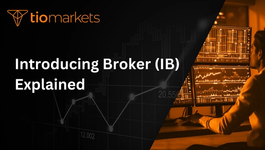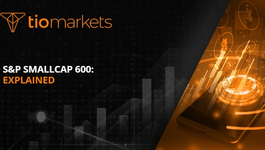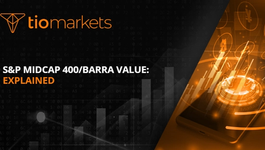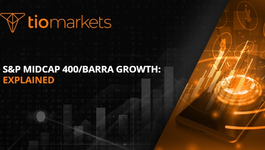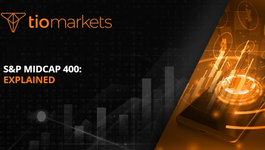Minimum acceptable rate of return: Explained
BY TIOmarkets
|August 3, 2024In the world of trading, the term 'Minimum Acceptable Rate of Return' (MARR) is a key concept that every trader must understand. It is the lowest return that an investor or trader is willing to accept on an investment. This rate is determined by various factors such as risk tolerance, inflation, and the potential return of other investments. This article will delve into the intricacies of MARR, its calculation, and its implications in trading.
The MARR is an essential tool in the decision-making process of investing and trading. It serves as a benchmark against which potential investments are evaluated. If the expected return on an investment is below the MARR, the investment is not considered worthwhile. Conversely, if the expected return is above the MARR, the investment is deemed attractive. This article will provide a comprehensive understanding of the MARR and its role in trading.
Understanding the Concept of MARR
The Minimum Acceptable Rate of Return is a crucial concept in finance and trading. It is the lowest return that an investor is willing to accept for an investment. The MARR is not a fixed number; it varies from investor to investor based on their individual risk tolerance, investment goals, and other factors. It is a subjective measure that reflects an investor's expectations and preferences.
Understanding the MARR is essential for making informed investment decisions. It helps investors evaluate potential investments and determine whether they meet their return expectations. If an investment's expected return is below the MARR, the investor may choose to forego the investment. On the other hand, if the expected return is above the MARR, the investor may decide to pursue the investment.
Role of MARR in Trading
In trading, the MARR plays a vital role in the decision-making process. Traders use the MARR as a benchmark to evaluate potential trades. If the expected return on a trade is below the MARR, the trader may decide not to execute the trade. Conversely, if the expected return is above the MARR, the trader may choose to execute the trade.
The MARR also helps traders manage their risk. By setting a minimum acceptable return, traders can ensure that they are adequately compensated for the risks they take. This can help prevent traders from taking on excessively risky trades that do not offer sufficient returns.
Factors Influencing MARR
The MARR is influenced by a variety of factors. One of the primary factors is the risk tolerance of the investor or trader. Individuals with a high risk tolerance may be willing to accept a lower MARR, while those with a low risk tolerance may require a higher MARR. Other factors that can influence the MARR include the inflation rate, the potential return of other investments, and the investor's or trader's personal financial goals.
It's also worth noting that the MARR can change over time. As market conditions, personal circumstances, and financial goals evolve, an investor or trader may adjust their MARR accordingly. This flexibility allows the MARR to remain a relevant and useful tool in the investment decision-making process.
Calculating the MARR
The calculation of the MARR is a subjective process that takes into account the individual investor's or trader's risk tolerance, investment goals, and other factors. There is no one-size-fits-all formula for calculating the MARR. Instead, each investor or trader must determine their own MARR based on their unique circumstances and preferences.
However, there are some common methods that can be used to calculate the MARR. One method is to use the risk-free rate as a starting point and then add a risk premium to account for the additional risk of the investment. The risk-free rate is the return on a risk-free investment, such as a government bond. The risk premium is the additional return required to compensate for the risk of the investment. The sum of the risk-free rate and the risk premium is the MARR.
Using the Risk-Free Rate
The risk-free rate is a common starting point for calculating the MARR. This is the return on an investment that is considered to be free of risk, such as a government bond. The risk-free rate serves as a baseline for the MARR, reflecting the minimum return that an investor or trader would accept without taking on any additional risk.
However, most investments and trades involve some level of risk. Therefore, the risk-free rate is typically not sufficient as a MARR. Instead, an additional risk premium is added to the risk-free rate to account for the risk of the investment or trade. This risk premium reflects the additional return that the investor or trader requires to compensate for the risk of the investment or trade.
Adding a Risk Premium
The risk premium is an important component of the MARR. It is the additional return that an investor or trader requires to compensate for the risk of an investment or trade. The risk premium is determined based on the investor's or trader's risk tolerance and the specific risks associated with the investment or trade.
The size of the risk premium can vary widely depending on the investor's or trader's risk tolerance and the riskiness of the investment or trade. For example, an investor or trader with a high risk tolerance may require a smaller risk premium, while one with a low risk tolerance may require a larger risk premium. Similarly, an investment or trade with a high level of risk may warrant a larger risk premium, while one with a low level of risk may warrant a smaller risk premium.
Implications of MARR in Trading
The MARR has significant implications in trading. It serves as a benchmark against which potential trades are evaluated. By comparing the expected return of a trade to the MARR, traders can make informed decisions about whether to execute the trade.
The MARR also helps traders manage their risk. By setting a minimum acceptable return, traders can ensure that they are adequately compensated for the risks they take. This can help prevent traders from taking on excessively risky trades that do not offer sufficient returns.
Trade Evaluation
One of the primary uses of the MARR in trading is for trade evaluation. Traders use the MARR as a benchmark to evaluate potential trades. If the expected return on a trade is below the MARR, the trader may decide not to execute the trade. Conversely, if the expected return is above the MARR, the trader may choose to execute the trade.
This use of the MARR helps traders make informed decisions about their trades. It provides a clear and objective standard against which potential trades can be evaluated. This can help traders avoid making impulsive or emotionally-driven trading decisions.
Risk Management
The MARR also plays a crucial role in risk management. By setting a minimum acceptable return, traders can ensure that they are adequately compensated for the risks they take. This can help traders avoid taking on excessively risky trades that do not offer sufficient returns.
Furthermore, the MARR can help traders maintain a balanced and diversified portfolio. By requiring a minimum return on each trade, traders can avoid over-concentration in high-risk trades. This can help reduce the overall risk of the trading portfolio and enhance its potential for long-term growth.
Conclusion
The Minimum Acceptable Rate of Return is a vital concept in trading. It serves as a benchmark against which potential trades are evaluated and plays a crucial role in risk management. Understanding the MARR and how to calculate it can help traders make informed trading decisions and manage their risk effectively.
While the MARR is a subjective measure that varies from trader to trader, it is a valuable tool in the trading process. By setting a MARR, traders can ensure that they are adequately compensated for the risks they take and can avoid taking on excessively risky trades that do not offer sufficient returns. This can enhance the potential for long-term growth and success in trading.
Start Trading with Confidence at TIOmarkets
Now that you understand the importance of the Minimum Acceptable Rate of Return in your trading decisions, take the next step with TIOmarkets. Join over 170,000 traders in more than 170 countries who have chosen our top-rated platform for trading Forex, indices, stocks, commodities, and futures markets. With low fees and access to over 300 instruments across 5 markets, TIOmarkets provides you with the tools to trade effectively. Enhance your trading skills with our comprehensive educational resources and step-by-step guides. Ready to embark on your trading journey? Create a Trading Account today and trade with the assurance that you're backed by a broker committed to your success.

Risk disclaimer: CFDs are complex instruments and come with a high risk of losing money rapidly due to leverage. You should consider whether you understand how CFDs work and whether you can afford to take the high risk of losing your money. Never deposit more than you are prepared to lose. Professional client’s losses can exceed their deposit. Please see our risk warning policy and seek independent professional advice if you do not fully understand. This information is not directed or intended for distribution to or use by residents of certain countries/jurisdictions including, but not limited to, USA & OFAC. The Company holds the right to alter the aforementioned list of countries at its own discretion.
Join us on social media

Behind every blog post lies the combined experience of the people working at TIOmarkets. We are a team of dedicated industry professionals and financial markets enthusiasts committed to providing you with trading education and financial markets commentary. Our goal is to help empower you with the knowledge you need to trade in the markets effectively.
